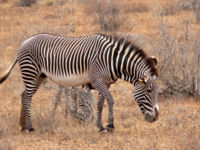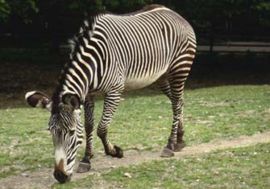
Equus grevyi
Alexandra E. Price
Nutrition
 Since Grevy's zebras
live in arid shrub and grassland, they are
predominantly grazers. In
stressful situations, such as a drought,
they are known to eat browse (twigs,
leaves of trees, and shrubs).
Browse can comprise up to 30% of their
diet in these situations. Although
zebras prefer to drink daily, adults
can tolerate two to five days without
water, but lactating females can only go
one to two days without replenishment.
Since Grevy's zebras
live in arid shrub and grassland, they are
predominantly grazers. In
stressful situations, such as a drought,
they are known to eat browse (twigs,
leaves of trees, and shrubs).
Browse can comprise up to 30% of their
diet in these situations. Although
zebras prefer to drink daily, adults
can tolerate two to five days without
water, but lactating females can only go
one to two days without replenishment.
Grevy's zebras have a
caecal digestive system (non-ruminant) which requires
high food intake, favoring quantity over
quality. A diet of Kenyan grasses,
legumes, and browse provides all the
minerals required by the zebras. Legumes provide
more protein and phosphorus, but
less fiber, than grass or browse.
Browse has a good amount of calcium
in it as well.
by the zebras. Legumes provide
more protein and phosphorus, but
less fiber, than grass or browse.
Browse has a good amount of calcium
in it as well.
Mixed herds graze away from water in the early morning, rest in the shade during mid-day, and return to water in the mid-afternoon. They graze away from water overnight. When grazing, Grevy's often make an open arc formation which enables them to watch for predators and be less competitive in feeding.
But who do Grevy's share their nutrients with?
Grevy's zebras share
their habitat and associate for mutual
protection from predators with
wildebeest, beisa oryx, waterbuck, kudu,
eland, and the
giraffe. They also live
in certain areas of Kenya with plains
zebra, or Equus burchelli,
pictured watering to the right.![Clip Art: zebras drinking [NOTE: These are not Grevy's zebra, instead plains zebras]](thirstyzebras.jpg)
Zebras bunch when alarmed and the closer they bunch the greater the apprehension. Watering involves potential danger from predators, such as lions and hyenas, or interactions with larger animals such as elephants (more specifically the African elephant) or cape buffalos. Watering is herd activity because of these threats.
Alarmed Grevy's zebras give deep, hoarse grunts which carry well and resemble those of lions. They may also whistle or squeal when alarmed, fighting, or in pain or fearful.
Copyright © 2007, Design by: Sunlight webdesign